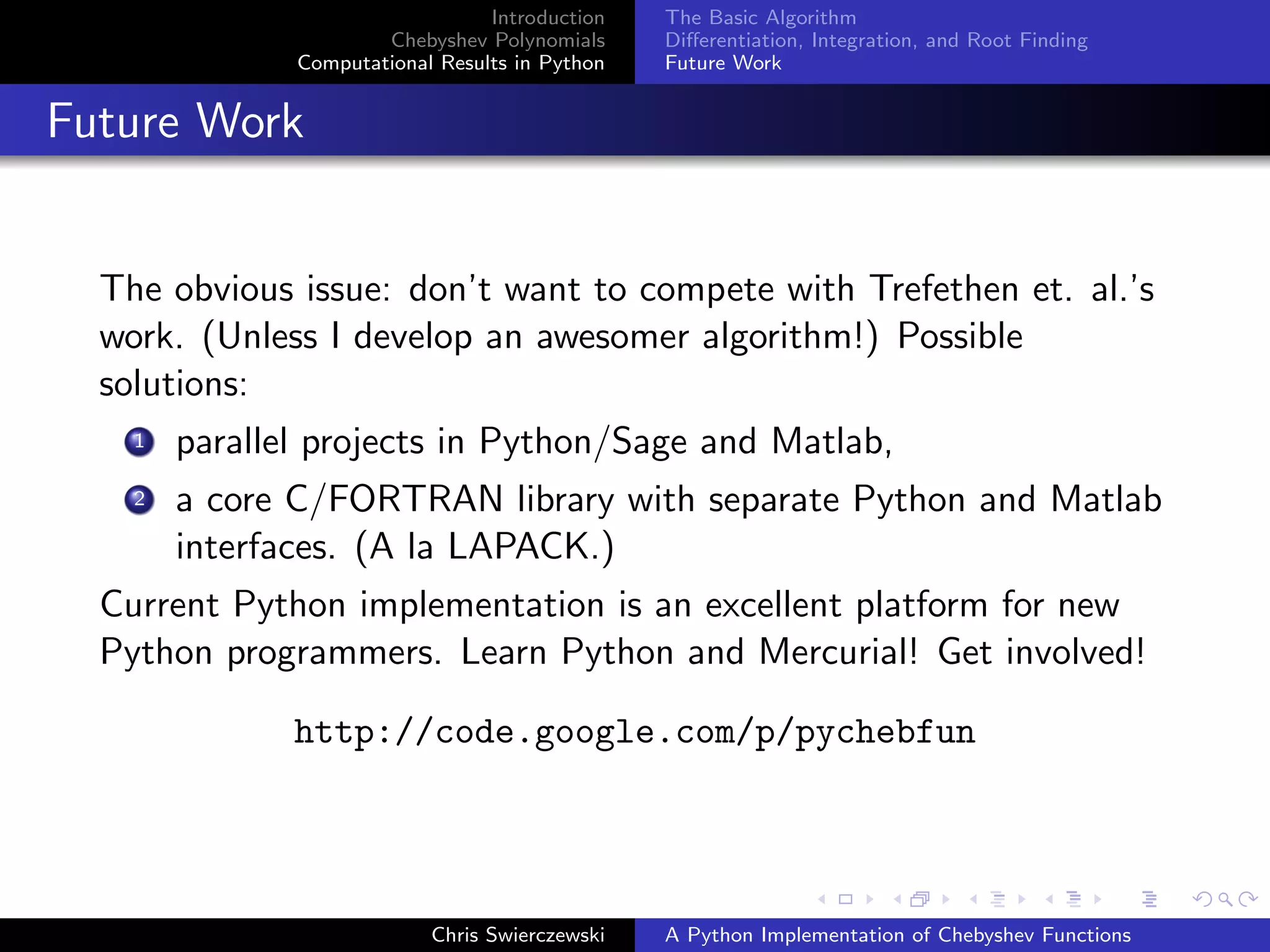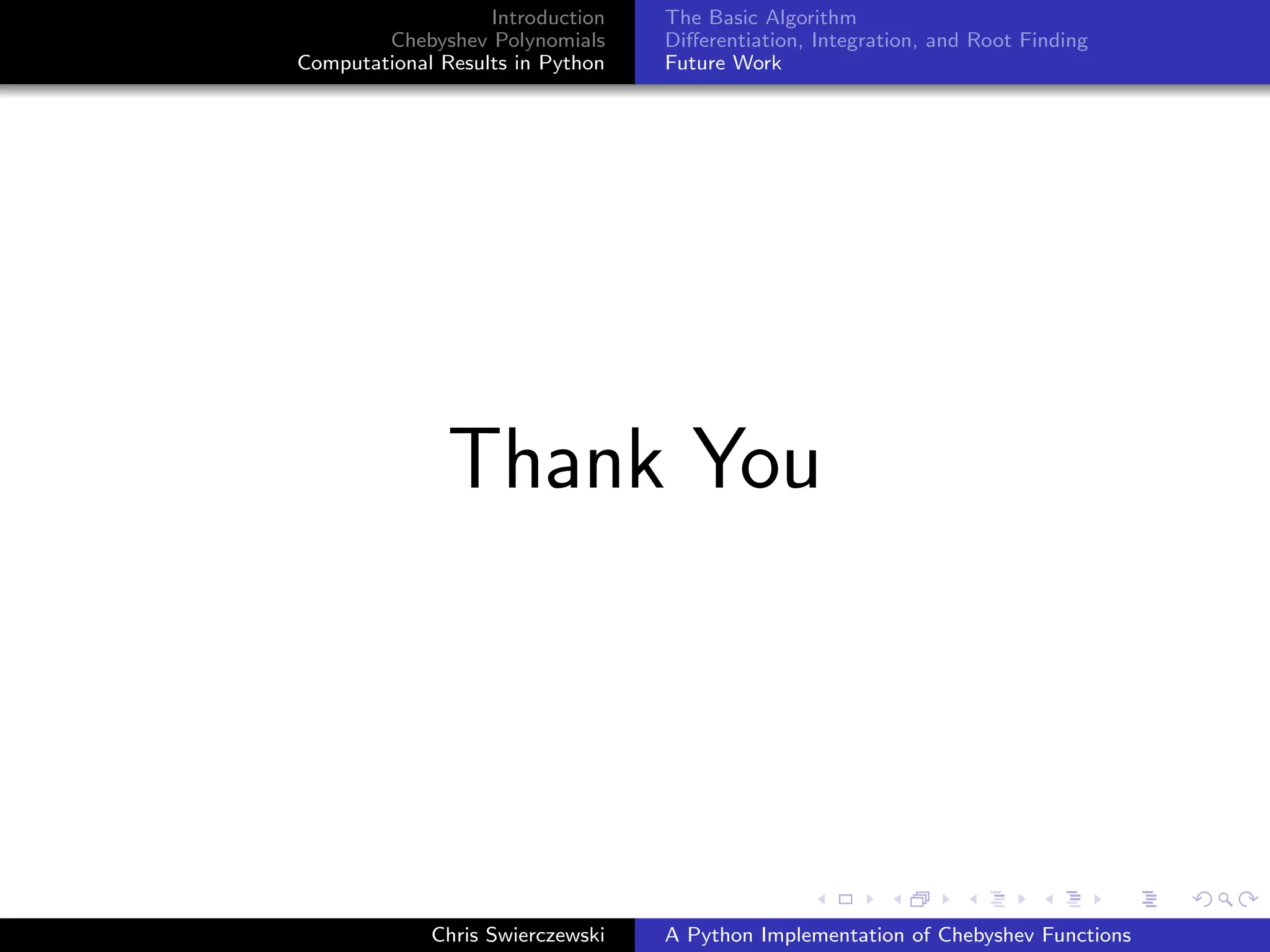This document describes Chebyshev polynomials and their use in spectral methods. It discusses:
- Using Lagrange interpolation over Chebyshev points to get near-best polynomial approximations.
- Representing functions on [-1,1] as Chebyshev polynomial expansions for fast computations.
- Defining a "Chebfun" as a minimal-degree interpolant using this representation.
- Algorithms for differentiating, integrating, and finding roots of Chebfuns efficiently in Python.
- Future work on using Chebfuns to solve differential equations spectrally.
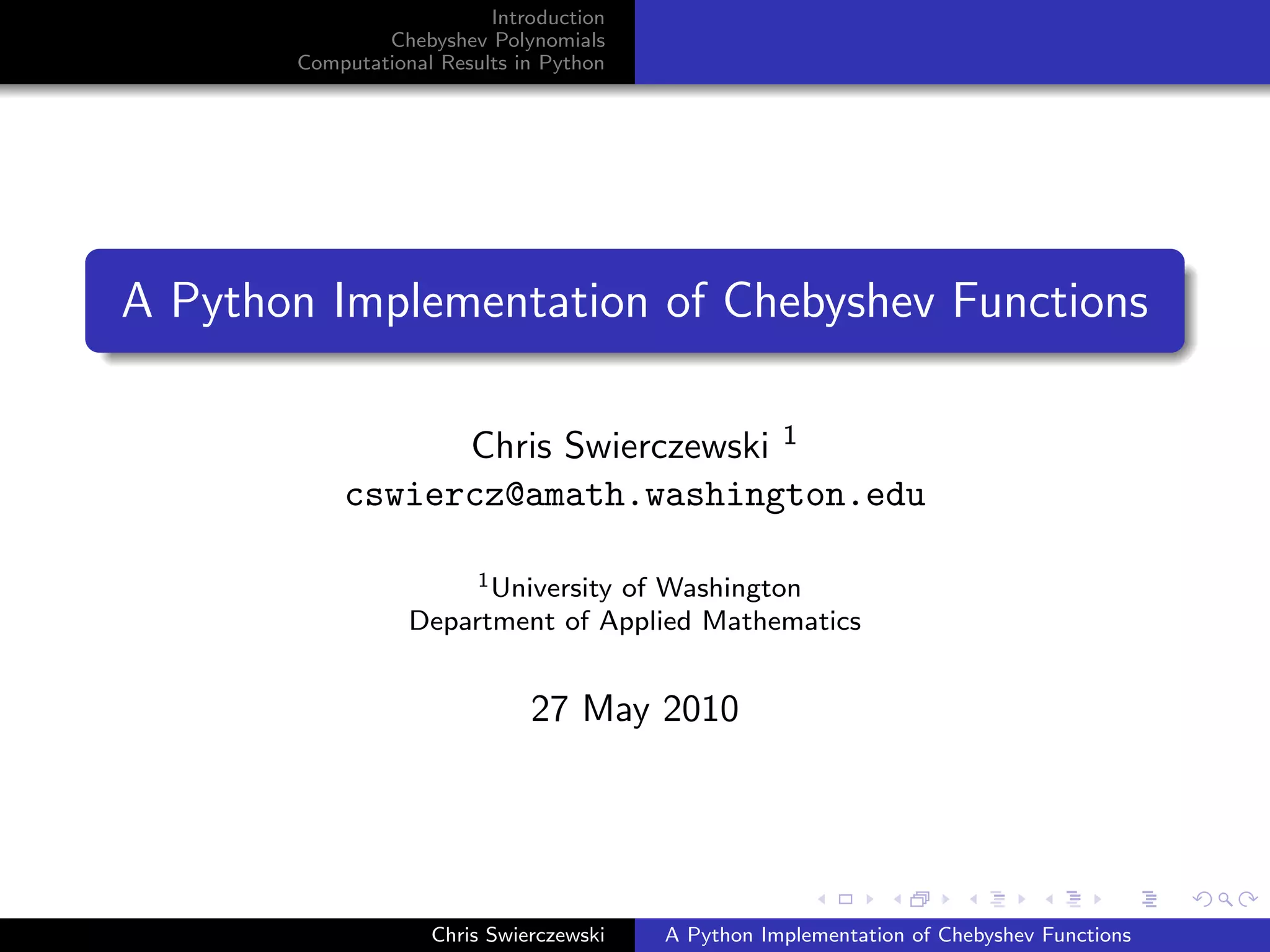

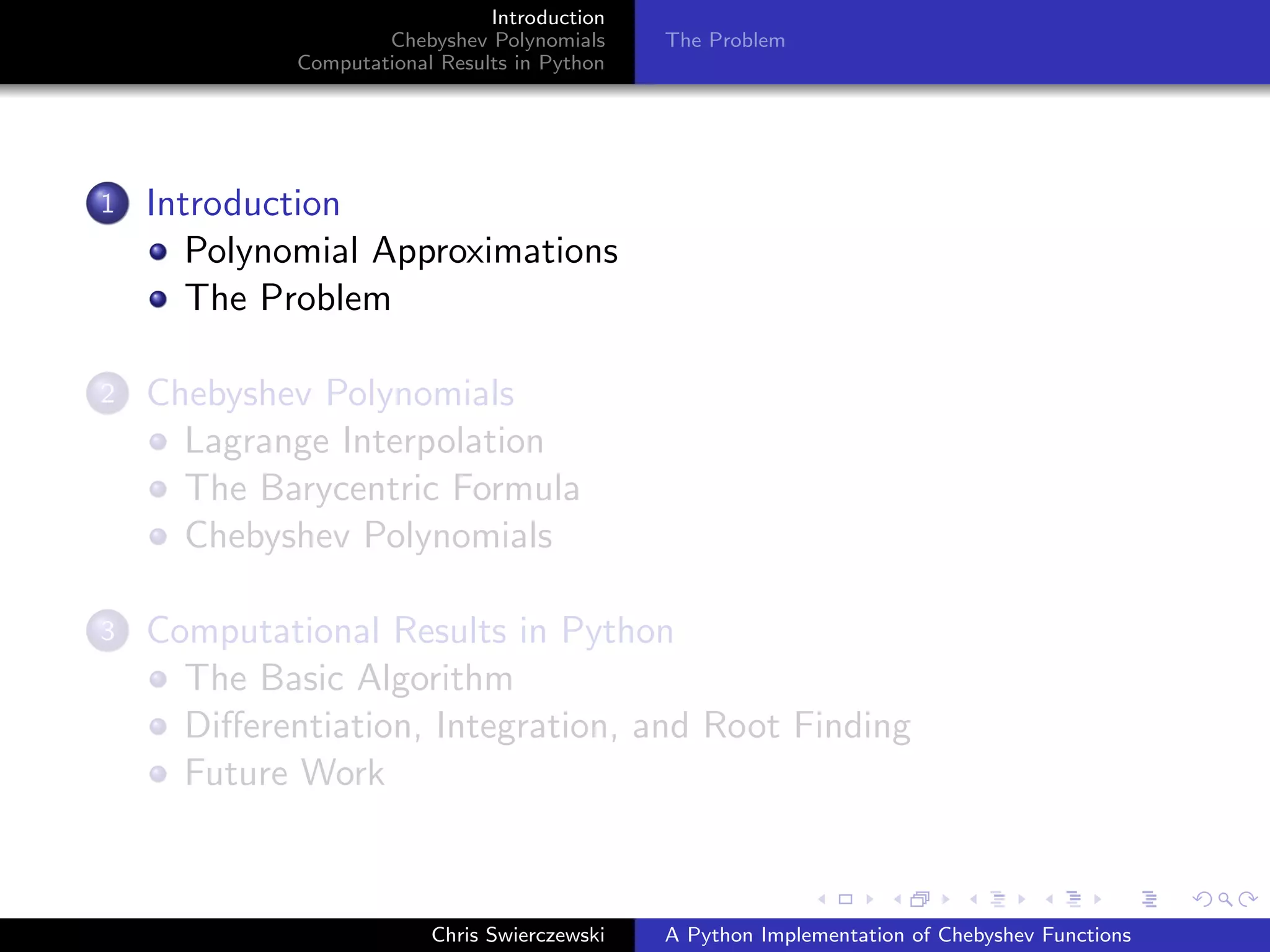
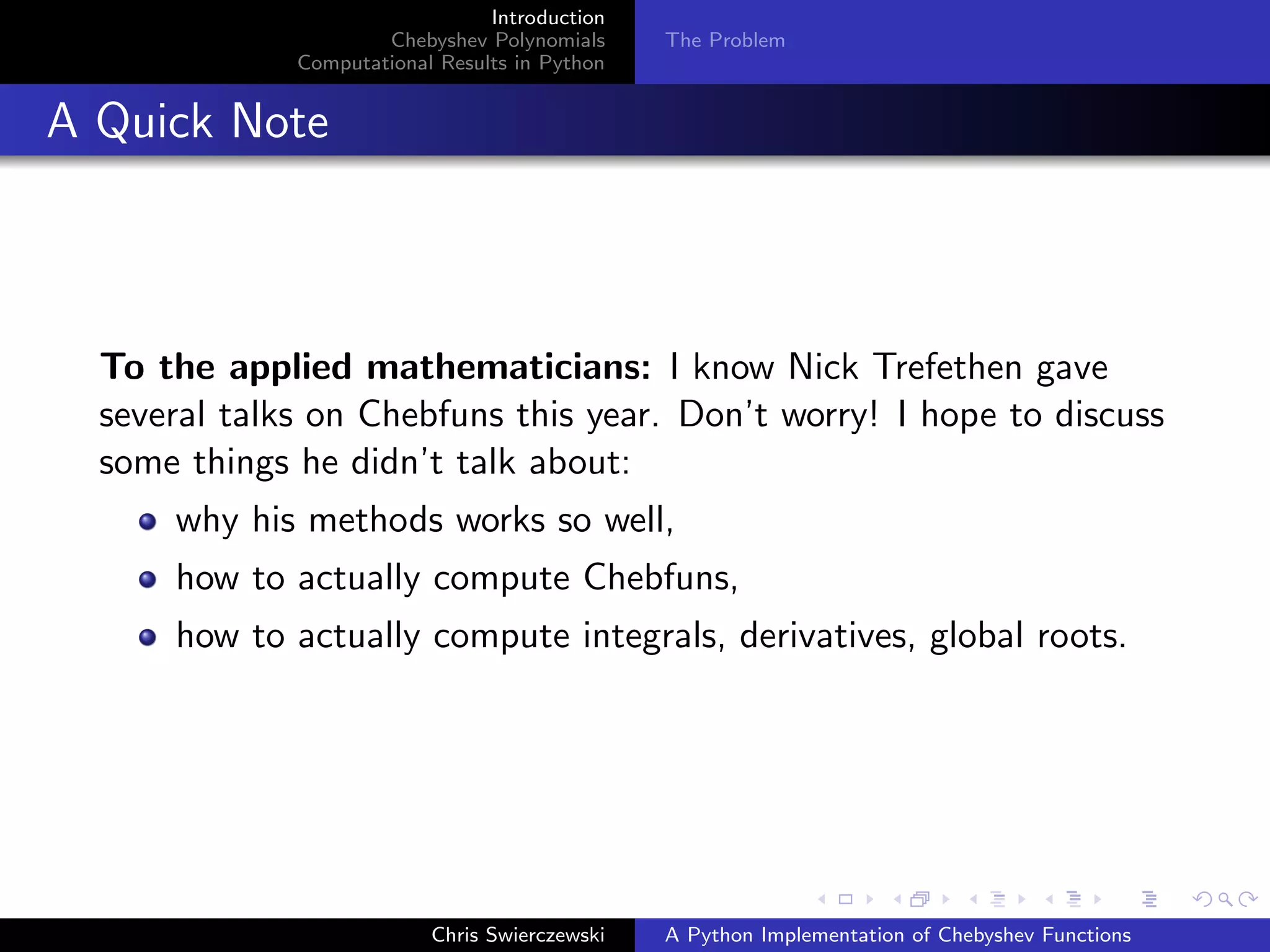
![Introduction
Chebyshev Polynomials
Computational Results in Python
The Problem
Two Key Theorems
Weierstrass Approximation Theorem on R (1885)
Suppose f ∈ C0[a, b]. Then ∀ > 0, ∃p polynomial such that
||f − p||∞ < on [a, b].
(Interesting corrolary: R[x] is dense in C0
[a, b]. Q[x] is dense in R[x].
Therefore |C0
[−1, 1]| = |R|.)
Restriction to Degree n Polynomials: Pn
Given f ∈ C0[a, b] find p∗ ∈ Pn such that
||f − p∗
||∞ ≤ ||f − p||∞ for all p ∈ Pn
Fact: p∗
exists, is unique, and goes by the name “best”, “uniform”,
“Chebyshev”, or “minimax” approximation to f .
Chris Swierczewski A Python Implementation of Chebyshev Functions](https://image.slidesharecdn.com/73febfd4-b8f7-4e87-9fed-fce5d6fecea0-150709172504-lva1-app6892/75/masters-presentation-5-2048.jpg)
![Introduction
Chebyshev Polynomials
Computational Results in Python
The Problem
Objective
Main Goal
Given f : [−1, 1] → R, find a polynomial of lowest degree that
approximates f to within machine epsilon. That is, find
pgoal = min
p,deg(p)
||f − p||∞ < mach
Trefethen’s method: look at polynomials with a particular structure
that make derivatives, integrals, and roots easy to compute.
Use these tools:
Structure #1: Lagrange interpolants
Structure #2: Chebyshev polynomial expansions
Chris Swierczewski A Python Implementation of Chebyshev Functions](https://image.slidesharecdn.com/73febfd4-b8f7-4e87-9fed-fce5d6fecea0-150709172504-lva1-app6892/75/masters-presentation-6-2048.jpg)
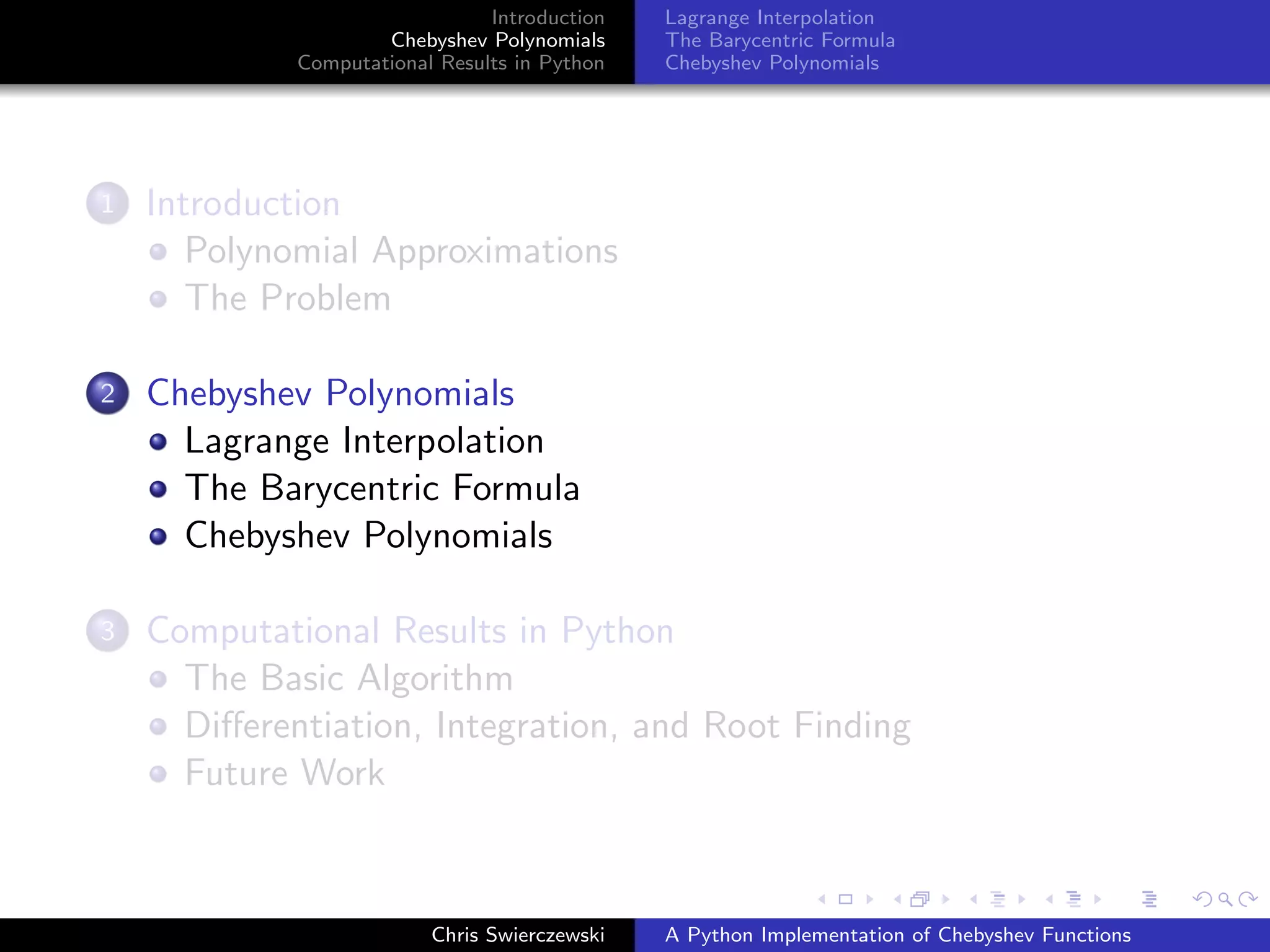
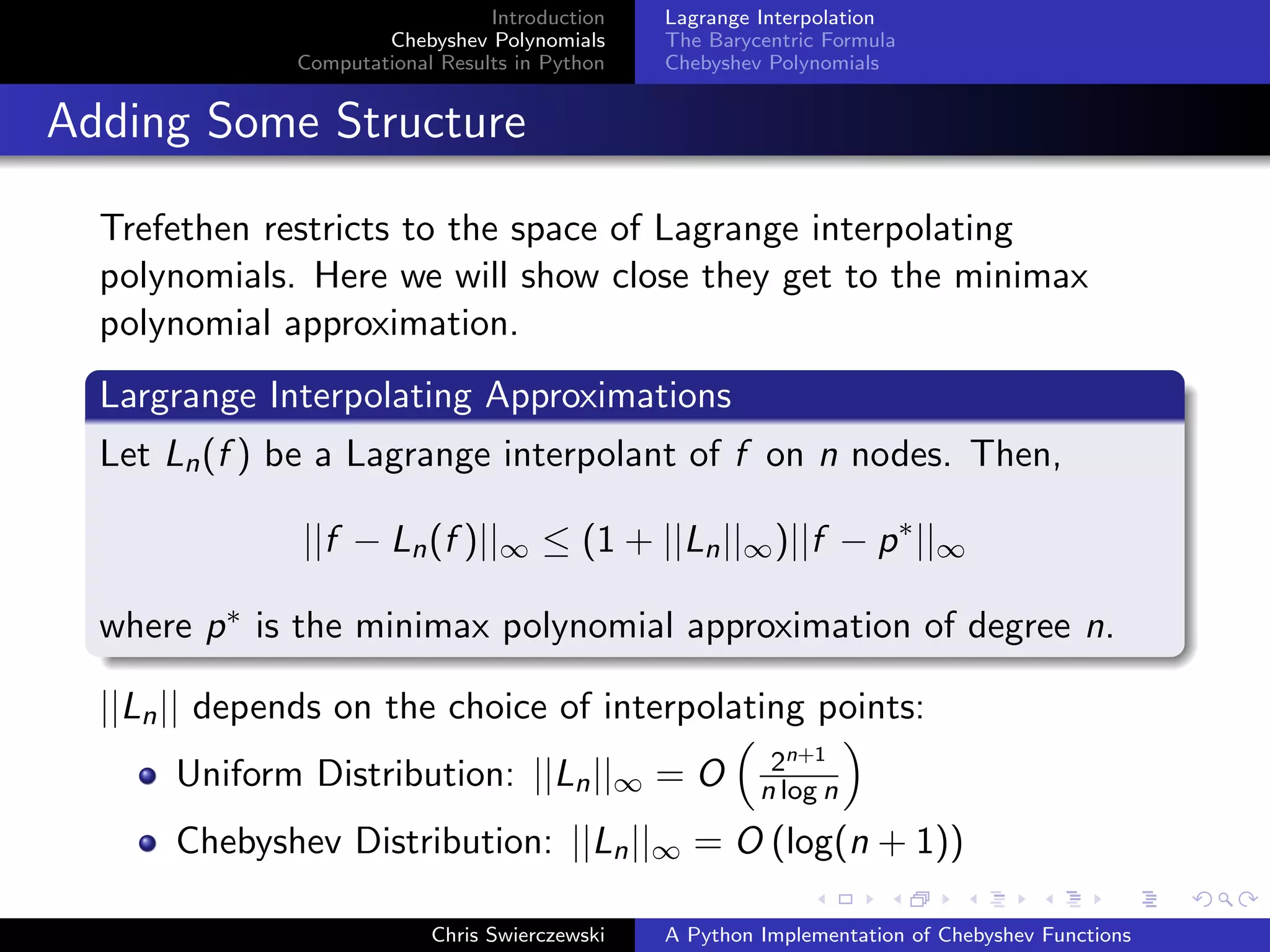
![Introduction
Chebyshev Polynomials
Computational Results in Python
Lagrange Interpolation
The Barycentric Formula
Chebyshev Polynomials
More Reasons to Use Lagrange Interpolation
Lagrange Interpolants over the Chebyshev points have good
convergence properties:
Bounded Variation
If ∂kf : [−1, 1] → R has bounded variation for some k ≥ 1 then
||f − Ln(f )|| = O(n−k
)
Analyticity
If f is analytic in a neigborhood of [−1, 1] then
||f − Ln(f )|| = O(Cn
)
for some C < 1.
Chris Swierczewski A Python Implementation of Chebyshev Functions](https://image.slidesharecdn.com/73febfd4-b8f7-4e87-9fed-fce5d6fecea0-150709172504-lva1-app6892/75/masters-presentation-9-2048.jpg)
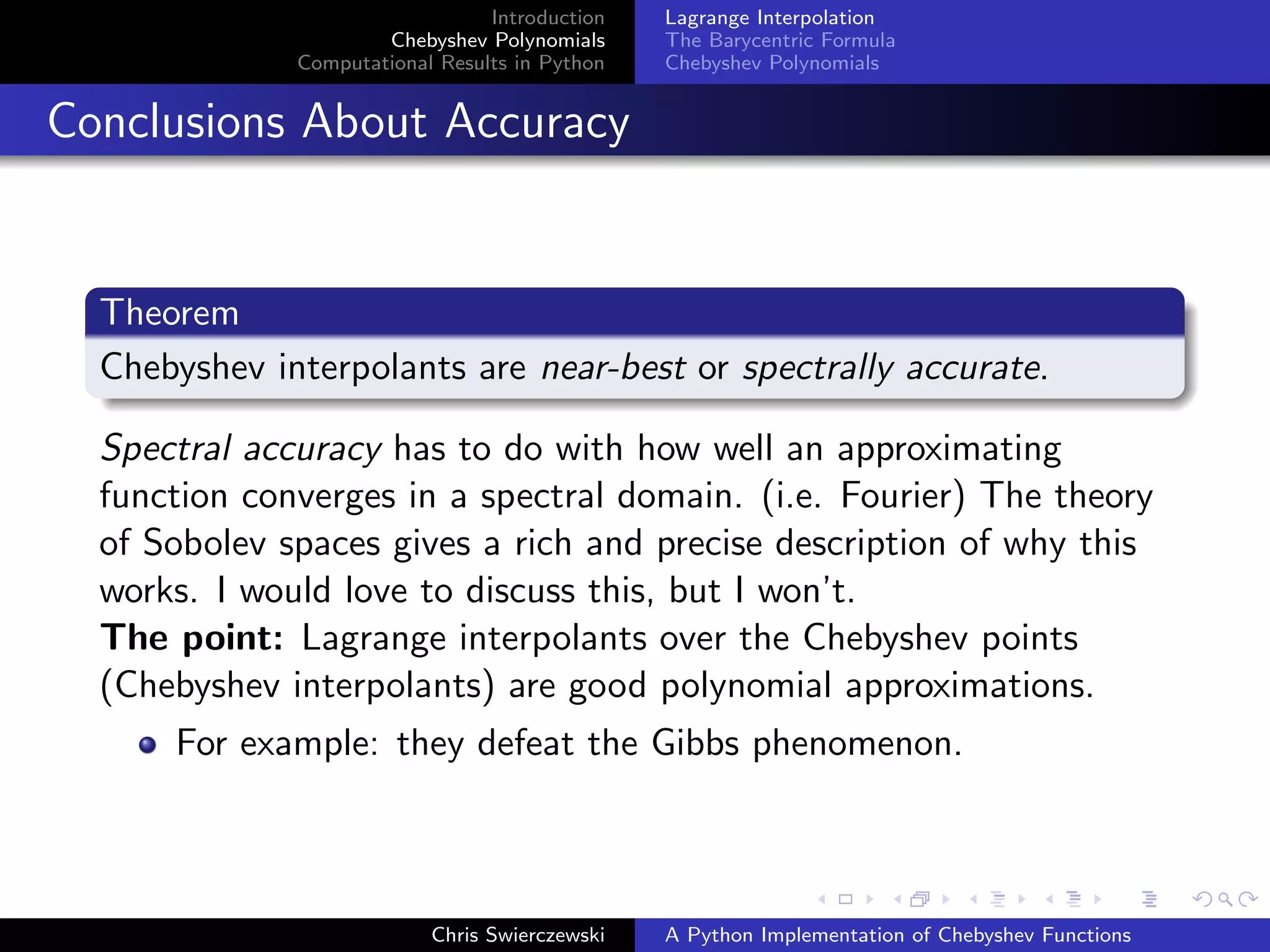
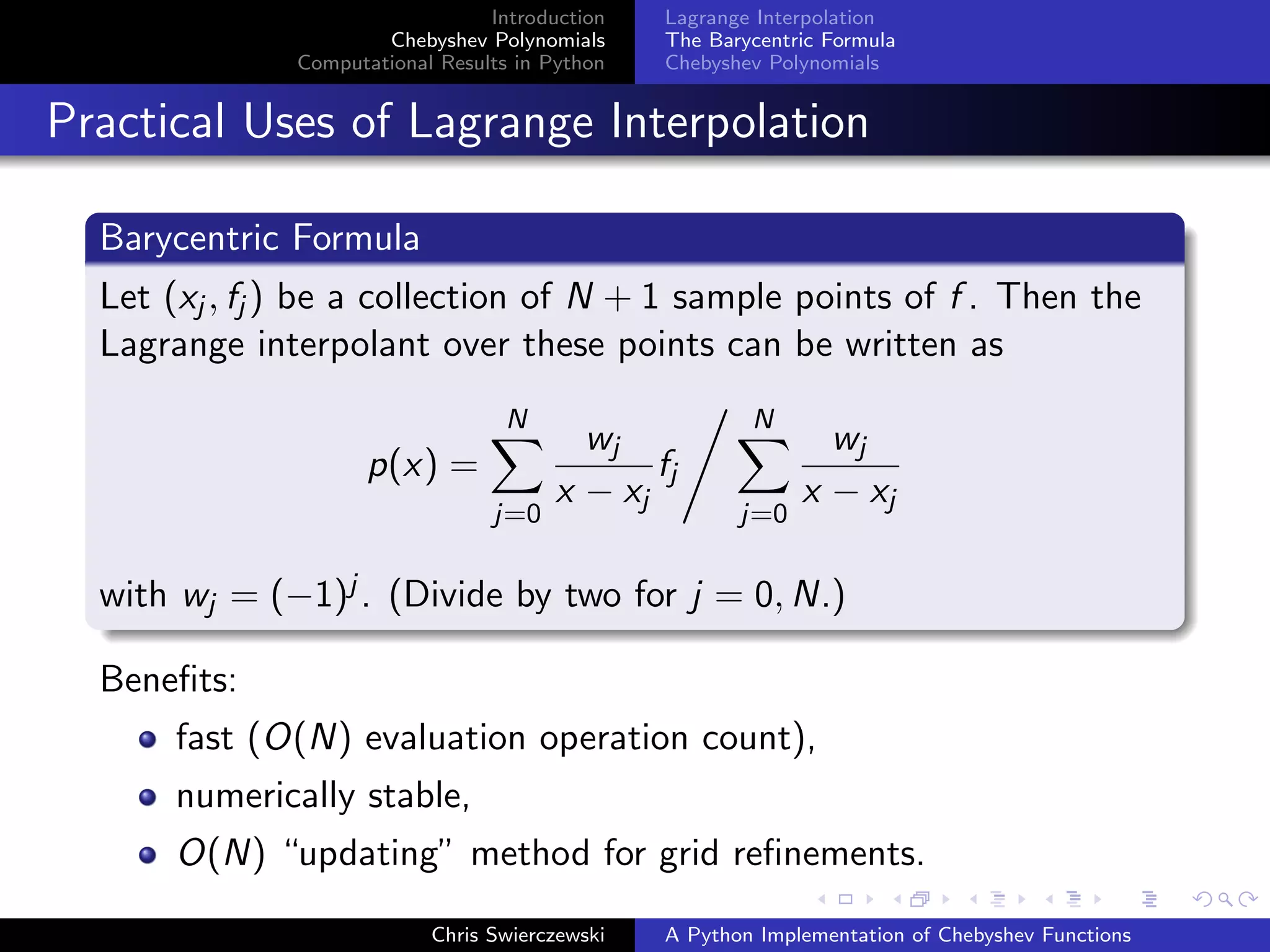
![Introduction
Chebyshev Polynomials
Computational Results in Python
Lagrange Interpolation
The Barycentric Formula
Chebyshev Polynomials
Why Restriction to [−1, 1]?
Summary so far: we’ve seen the benefits of using Lagrange
interpolation over the Chebyshev points and how the Barycentric
formula allows O(N) evaluation as well as O(N) method of adding
Chebyshev points.
Trefethen exploits another structure: consider only f : [−1, 1] → R
Chebyshev Polynomials
The Chebyshev polynomials Tn : [−1, 1] → R are defined:
T0(x) = 1
T1(x) = x
Tn+1(x) = 2xTn(x) − Tn−1(x)
Chris Swierczewski A Python Implementation of Chebyshev Functions](https://image.slidesharecdn.com/73febfd4-b8f7-4e87-9fed-fce5d6fecea0-150709172504-lva1-app6892/75/masters-presentation-12-2048.jpg)
![Introduction
Chebyshev Polynomials
Computational Results in Python
Lagrange Interpolation
The Barycentric Formula
Chebyshev Polynomials
Chebyshev Polynomial Expansions
Theorem (Trefethen)
If f : [−1, 1] → R is Lipschitz continuous then the Chebyshev
expansion
g(x) =
∞
n=0
anTn(x)
converges absolutely and uniformly to f . Additionally, the
Chebyshev coefficients are given by
an =
2
π
1
−1
f (x)Tn(x)
√
1 − x2
dx
with the special case that for n = 0 the constant changes to 1/π.
Chris Swierczewski A Python Implementation of Chebyshev Functions](https://image.slidesharecdn.com/73febfd4-b8f7-4e87-9fed-fce5d6fecea0-150709172504-lva1-app6892/75/masters-presentation-13-2048.jpg)
![Introduction
Chebyshev Polynomials
Computational Results in Python
Lagrange Interpolation
The Barycentric Formula
Chebyshev Polynomials
Relating Chebyshev Polynomials to Chebyshev Interpolants
Chebyshev Polynomial Representations
For x ∈ [−1, 1] define θ = arccos(x) ∈ [0, 2π] and z = eiθ. Then:
Tn(x) = cos nθ = 1
2 zn
+ z−n
For Chebyshev interpolants, this is a finite sum:
Expansion Representation
Let p be a Chebyshev interpolant determined by N + 1 grid points
(xi , fi ) over the Chebyshev points xi = cos(πi/N). Then
p(x) =
N
n=0
anTn(x) =
N
n=0
an cos(nθ) = 1
2
N
n=0
an(zn
+ z−n
)
Chris Swierczewski A Python Implementation of Chebyshev Functions](https://image.slidesharecdn.com/73febfd4-b8f7-4e87-9fed-fce5d6fecea0-150709172504-lva1-app6892/75/masters-presentation-14-2048.jpg)
![Introduction
Chebyshev Polynomials
Computational Results in Python
Lagrange Interpolation
The Barycentric Formula
Chebyshev Polynomials
Definition of Chebfun
Definition
A chebfun is a minimal degree Barycentric Lagrange interpolant of
a function f : [−1, 1] → R over the Chebyshev points that uses its
Chebyshev polynomial expansion for fast computations.
“Spectrally optimal approximate”
Next section: Given f ∈ Lip[−1, 1], compute its Chebfun, p.
Chris Swierczewski A Python Implementation of Chebyshev Functions](https://image.slidesharecdn.com/73febfd4-b8f7-4e87-9fed-fce5d6fecea0-150709172504-lva1-app6892/75/masters-presentation-15-2048.jpg)
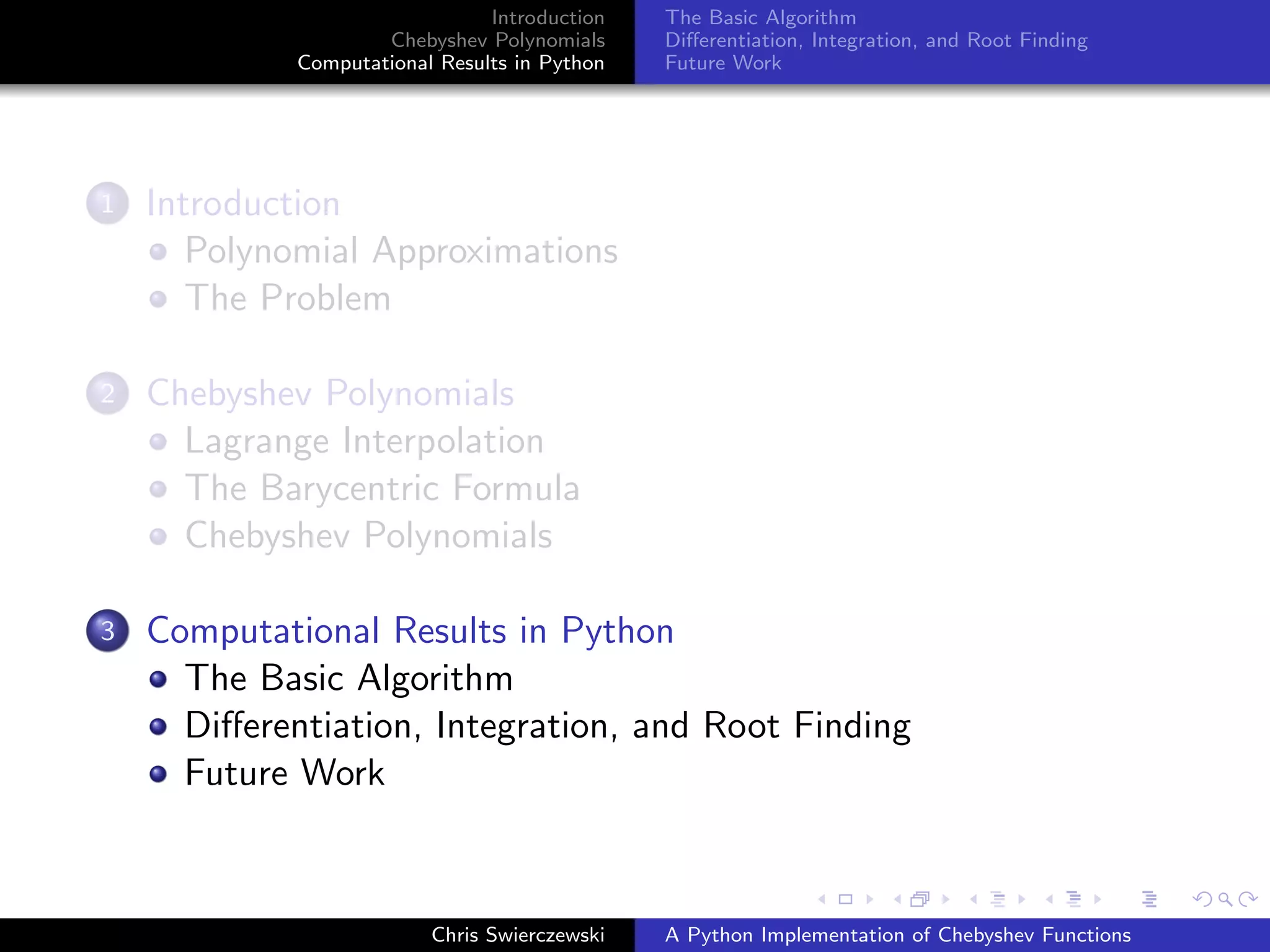
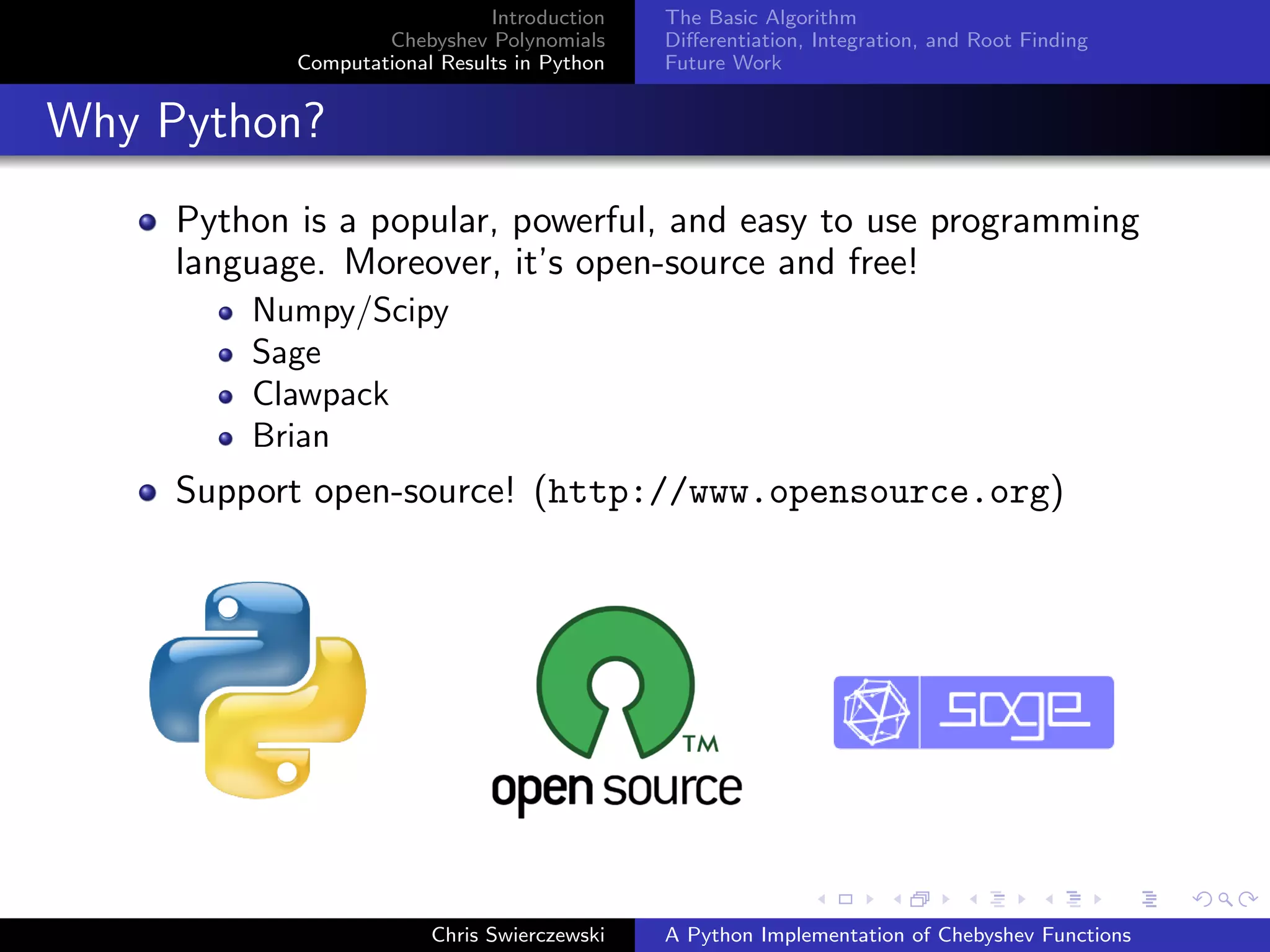
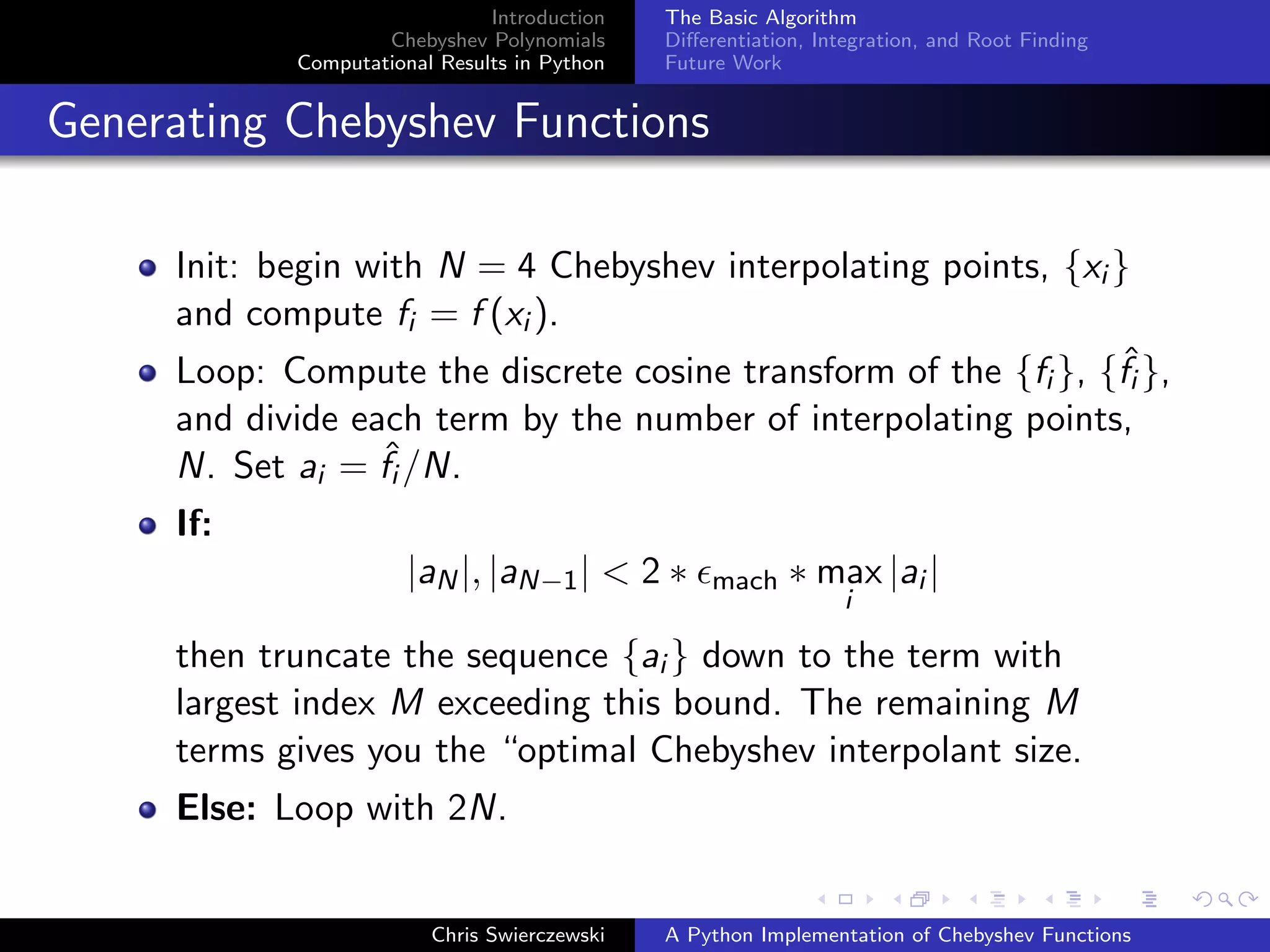

![Introduction
Chebyshev Polynomials
Computational Results in Python
The Basic Algorithm
Differentiation, Integration, and Root Finding
Future Work
Integration
Chebyshev Polynomial Integration
1
−1
Tn(x)dx =
0 if n odd
2
1−n2 if n even
Integral of a chebfun on [−1, 1]:
Clenshaw-Curtis Quadrature
Given a chebfun p(x) = N
n=0 anTn(x),
1
−1
p(x)dx =
N
n even
2
1 − n2
Chris Swierczewski A Python Implementation of Chebyshev Functions](https://image.slidesharecdn.com/73febfd4-b8f7-4e87-9fed-fce5d6fecea0-150709172504-lva1-app6892/75/masters-presentation-20-2048.jpg)

![Introduction
Chebyshev Polynomials
Computational Results in Python
The Basic Algorithm
Differentiation, Integration, and Root Finding
Future Work
Root Finding
Recall that Chebyshev coefficients {an} are the coefficients of the
Laurent series
q(z) =
N
n=0
an zn
+ z−n
.
The roots, zi of q, are the roots of zNq(z); a polynomial of
degree 2N in z.
Find the roots of zNq(z) using your favorite polynomial
root-finding algorithm. (Much easier than for a general
function.)
Roots come in pairs {zn, z−1
n }. Project back down to the real
axis with {zn, z−1
n } → 1
2(zn + z−1
n ) = xn.
Toss out any “roots” xn ∈ [−1, 1].
Chris Swierczewski A Python Implementation of Chebyshev Functions](https://image.slidesharecdn.com/73febfd4-b8f7-4e87-9fed-fce5d6fecea0-150709172504-lva1-app6892/75/masters-presentation-22-2048.jpg)
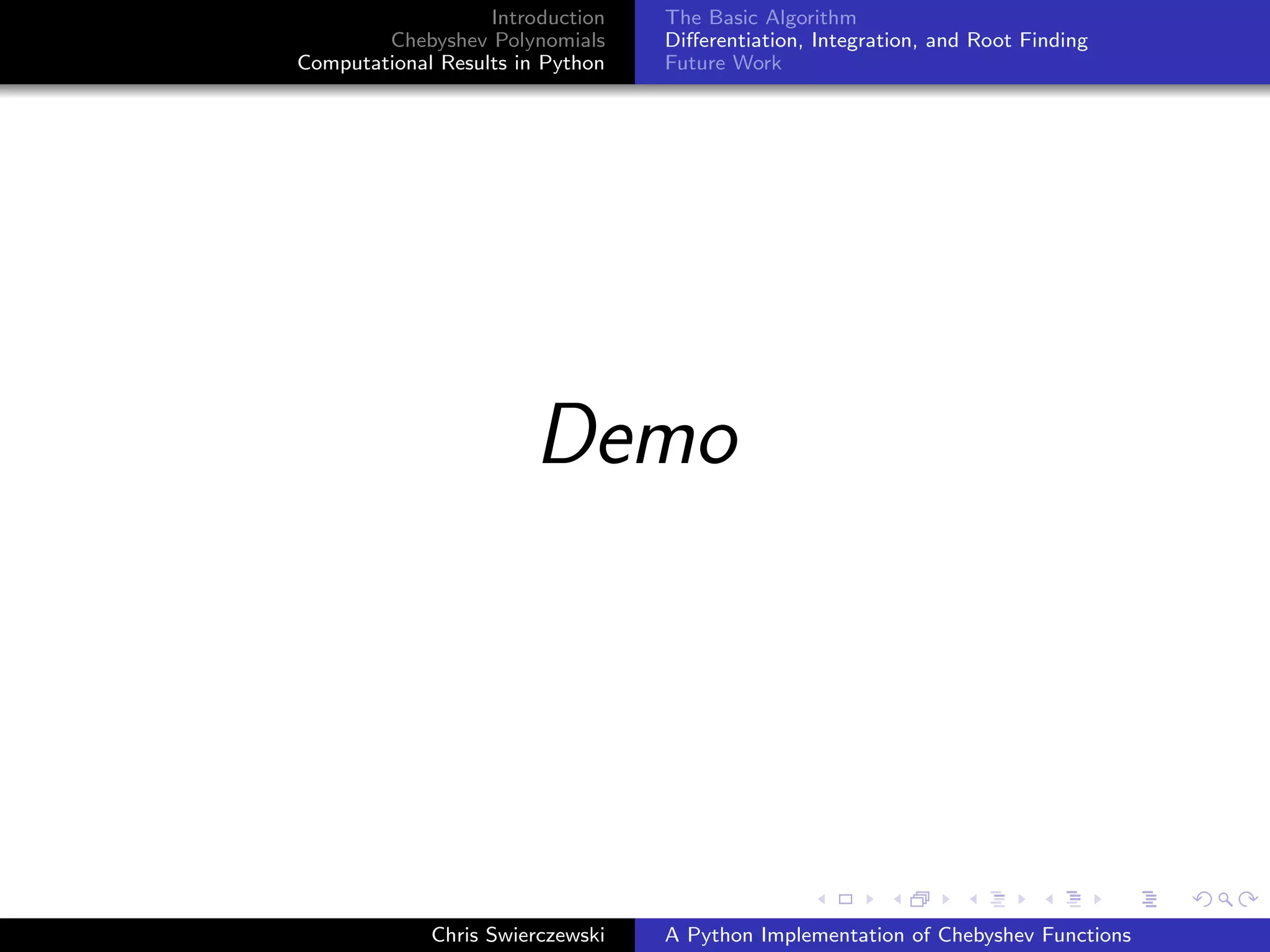
![Introduction
Chebyshev Polynomials
Computational Results in Python
The Basic Algorithm
Differentiation, Integration, and Root Finding
Future Work
Future Work
The real power of Chebyshev functions is in creating differential
operators and solving differential equations: given f ∈ L2[−1, 1]
solve
Lu = f .
Reduces to a dense (N × N) matrix solve.
Distinction from finite difference methods: spectral accuracy
is preserved! This means O( mach) accurate solutions, u.
You can implement this! (See next slide.)
Chris Swierczewski A Python Implementation of Chebyshev Functions](https://image.slidesharecdn.com/73febfd4-b8f7-4e87-9fed-fce5d6fecea0-150709172504-lva1-app6892/75/masters-presentation-24-2048.jpg)
